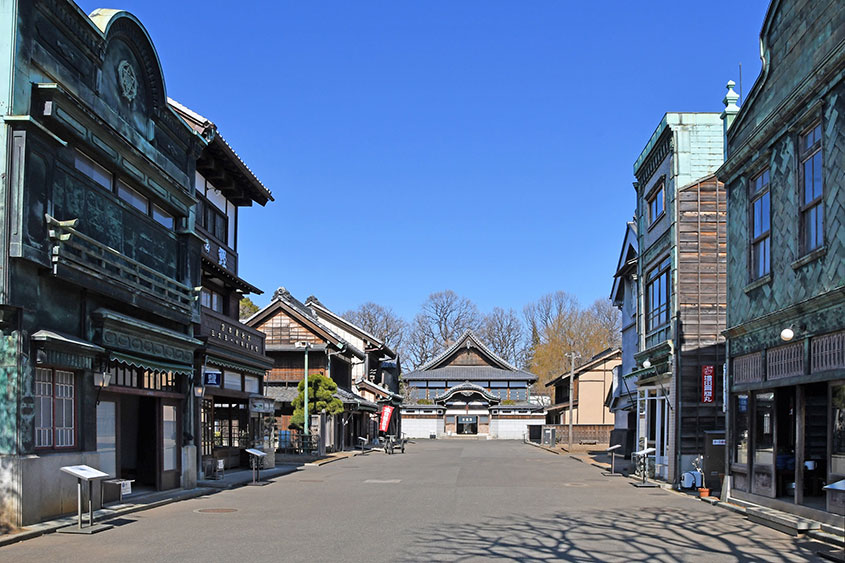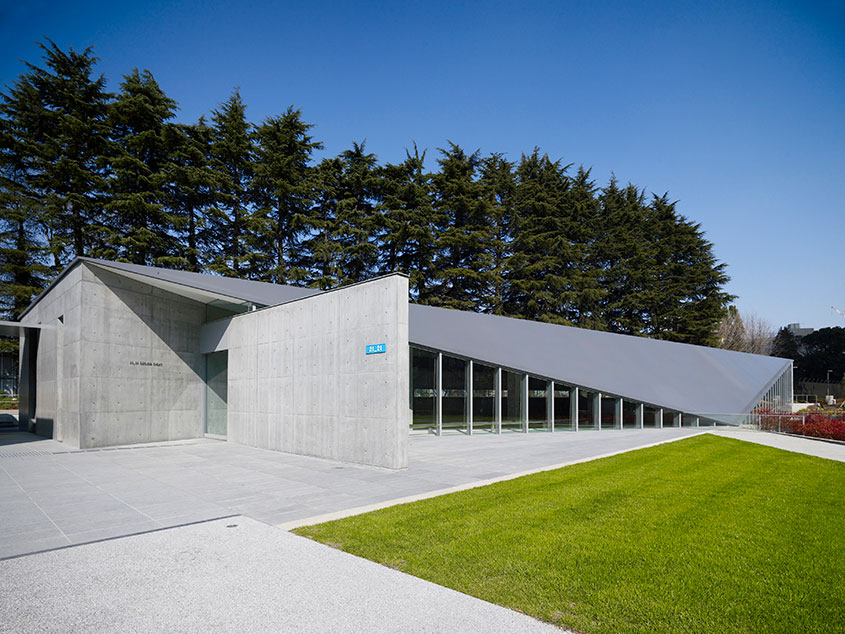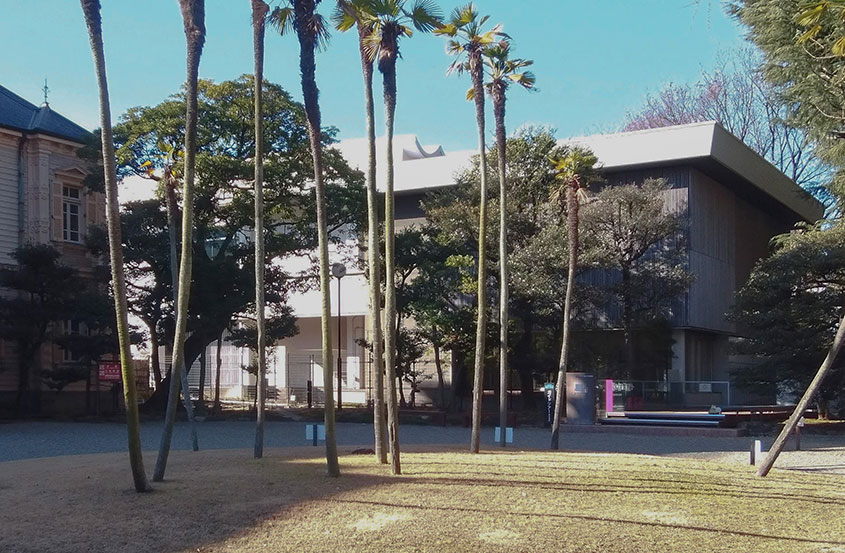Exploring the Past, Present and Future of Japanese Architecture in Tokyo
Tour Guide
Words by Mari Hashimoto

Around 80 years ago, Tokyo suffered heavy bombing during the Asia-Pacific War. As a result, it lost many buildings dating from the Edo period (1603-1868) or earlier. However, many talented architects emerged after the war, with Tokyo later coming to have one of the world’s largest assemblages of iconic modern buildings. This section introduces two facilities that provide a complex, in-depth insight into Tokyo’s architecture.
EDO-TOKYO OPEN AIR ARCHITECTURAL MUSEUM
Located near Tokyo’s Ryogoku Sumo Hall, the Edo-Tokyo Museum (scheduled to be closed until 2026) explores the history of Edo. Before becoming Tokyo, Edo was the seat of power for the Tokugawa Shogunate, with the Edo period commencing when Tokugawa Ieyasu established the shogunate at Edo Castle (now the Imperial Palace). The museum also has an annex called the Edo-Tokyo Open Air Architectural Museum, an outdoor museum that lies around 30km west of the Edo-Tokyo Museum in Koganei Park, Koganei City, Tokyo. The expansive 7-hectare site is home to 30 former residences and stores dating from the Edo period to the middle of the Showa era (1926-1989). These include Kagiya, a Japanese-style bar built at the end of the Edo period (in 1856) that has survived to the present day through fires and earthquakes; Kodakara-yu (built 1929), a representative example of a Tokyo public bath; and the former residence of Kunio Mayekawa (built 1942), an architect who played a major role in the development of Japan’s modern architecture. A visit here feels like stepping back in time, with the townscapes complimented by recreations of furniture, shop merchandise, eating utensils and other items from olden times.

Photo provided by the Edo-Tokyo Open Air Architectural Museum

Photo provided by the Edo-Tokyo Open Air Architectural Museum

Photo provided by the Edo-Tokyo Open Air Architectural Museum


EDO-TOKYO OPEN AIR ARCHITECTURAL MUSEUM
- Place
- 3-7-1 Sakuracho, Koganei-shi, Tokyo (inside Koganei Park)
- Time
- April~September:9:30 AM~5:30PM
October~March:9:30 AM~4:30PM
*Admission is allowed until 30 minutes before the closing time. - Closed
- Every Monday(When Monday is a national holiday, closed on the following day.)
New Year’s holidays. - Admissions
- Adults:One person 400yen Group(20 or more)320yen
65-years old or older:One person 200yen Group(20 or more)160yen
College students(incl. vocational schools):One person 320yen Group(20 or more)250yen
High school andjunior high school students(outside of Tokyo):One person 200yen Group(20 or more)160yen
Junior high school students(in Tokyo)
Primary school students and younger children:One person Free Group(20 or more)Free
*Admission for persons with certificates of physical, intellectual or mental disability and up to two attendants accompanying them is free.
*When Tokyo primary, junior high school and high school students and their teachers visit the museum as an educational activity, their admission is free. (Prior approval is required.)
*On the third Saturday and Sunday of every month (Family Day), admission for parents accompanied by a child younger than 18 years is half the normal price if resident in Tokyo.
*On the third Wednesday of every month (Silver Day), admission for visitors 65 years of age or older is free. (Identification certificate is required.) - Link
- https://www.tatemonoen.jp/english/
21_21 DESIGN SIGHT
21_21 DESIGN SIGHT is located within Tokyo Midtown, a shopping center in central Tokyo. Its origins lie in a movement spearheaded by the late designer Issey Miyake and others to create a museum that would serve as a base for design culture in Japan. The venue aims to redirect our eyes to everyday things and events, create various proposals and communicate numerous discoveries from a design point of view. Most of its exhibitions are directed by designers, with the graphic designer Taku Satoh serving as the institution's director. The building was designed by Tadao Ando based on Issey Miyake’s “A Piece of Cloth” clothing design concept, with 80% of the structure’s floor space built underground. Other nearby facilities include Suntory Museum of Art, Tokyo Midtown Design Hub, The National Art Center, Tokyo, Mori Art Museum, the design-themed multipurpose AXIS building, TOTO Gallery·Ma (a gallery specializing in architecture), and numerous design studios.





21_21 DESIGN SIGHT
- Place
- Midtown Garden, Tokyo Midtown, 9-7-6 Akasaka, Minato-ku, Tokyo 107-0052 JAPAN
- Time
- 10:00 - 19:00 (Entrance until 18:30)
- Closed
- Tuesdays, New Year Holidays, Installation Periods
- Admissions
- General ¥1,400 / University Students ¥800 / High School Students ¥500 / Junior High School Students and under may enter for free
* Valid Student ID must be provided upon entry.
* With a certification of disability, admission is free as well as that of an accompanying care-giver.
* Online tickets can be purchased through ArtSticker (https://artsticker.app/events/1351). Registration for an ArtSticker account is required to make a purchase.
* Payment Method by Credit Card (JCB, Visa, Mastercard®, American Express®, Diners Club, 銀聯card, major international brand from DISCOVER Group),transportation IC cards, QR code payment(WeChat Pay, Alipay, PayPay, au PAY, Merpay)are accepted in 21_21 DESIGN SIGHT facilities. - Link
- https://www.2121designsight.jp/en/
National Archives of Modern Architecture, Agency for Cultural Affairs
The National Archives of Modern Architecture was established in 2013 to prevent materials related to modern Japanese architecture (drawings, photographs, sketches, models, etc.) from being damaged, scattered or lost overseas. Its voluminous collection of precious objects includes architectural design materials by Kiyonori Kikutake, Junzo Sakakura, Hiroshi Hara, Kunio Maekawa, and Takamasa Yoshizaka, for example. It also houses early architectural drawings from when the facility’s Honorary Director Ando Takao first established his own design office. The Archives stages around two special exhibitions a year and lies close to the Former Iwasaki House Garden, a Tokyo metropolitan park comprising the residence and gardens of the Iwasaki family, founders of Mitsubishi Zaibatsu, the predecessor to today’s Mitsubishi Group.

©️ National Archives of Modern Architecture

©️ National Archives of Modern Architecture

©️ National Archives of Modern Architecture

©️ National Archives of Modern Architecture

©️ National Archives of Modern Architecture
National Archives of Modern Architecture, Agency for Cultural Affairs
- Place
- 4-6-15 Yushima, Bunkyo-ku, Tokyo, 113-8553, Japan
- Time
- Open 10:00 Close 16:30
*Last entry is 15 minutes before closing. - Closed
- Closed on Monday
- Admissions
- Free
- Link
- https://nama.bunka.go.jp/global/eng.html

